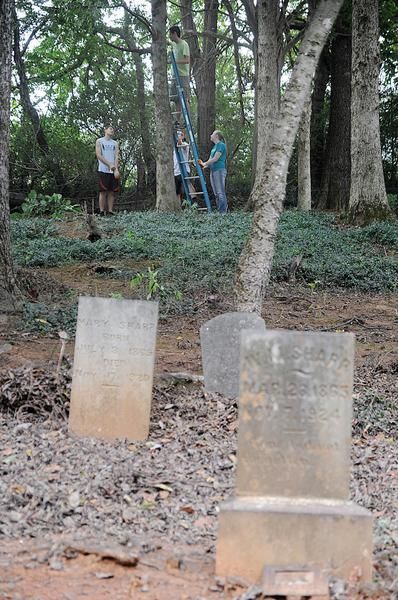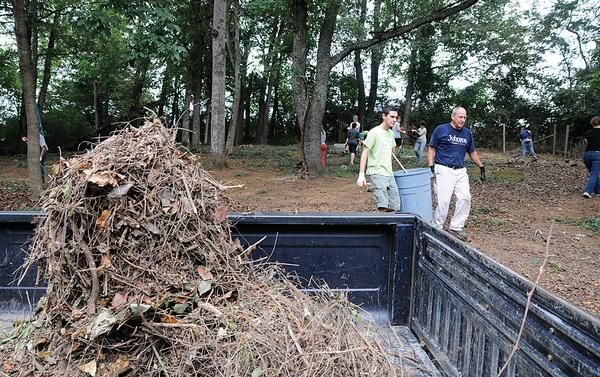
Notes:
Also known as Keener Slave Cemetery.
http://www.themountainpress.com/news/x1435696329/Students-clean-Seymour-cemetery-as-part-of-Johnson-University-project
Students clean Seymour cemetery as part of Johnson University project
Believed to be final resting place of former slaves, site was in disrepair
Sep. 20, 2013 @ 11:08 PM
JASON DAVIS

Johnson University students cut down limbs and brush along the back of the Trundles Crossroads Negro Cemetery. Over 700 students from the university fanned out around the region to do a day of volunteering.

Kevin O'Brien, the director of alumni and public relations, right, and student Luke East carry one of many trashcan loads of leaves and limbs.
SEYMOUR —
Seven hundred students from Johnson University fanned out across the region Wednesday to forgo an entire day of classes in favor of volunteering with 36 local nonprofit organizations.
As a part of the event, called K13, a group of over a dozen volunteers worked to revitalize the Trundles Crossroads Negro Cemetery — also known as the Keener Slave Cemetery — located behind St. Paul Episcopal Church off Boyds Creek Road in Seymour.
"Supposedly some slaves or former slaves are buried there," Kevin O'Brien, director of alumni and public relations, said Thursday. "The Methodist church — the building now serving as St. John’s Episcopal Church — was originally Trundles Crossroads United Methodist until the Holston Conference merged several small churches to form Seymour United Methodist. (It) allowed African-Americans to be buried in the space which adjoined the community cemetery used by Caucasians."
"It is believed the cemetery was established after the Civil War when the slaves were freed and were therefore no longer buried in plantation cemeteries," Sevier County Historian Carroll McMahan said. "Several of the surnames are the same as slave-owning families in the Boyd’s Creek area."
Known to be buried in the cemetery are John Paul Chandler (1906-1923); Infant Davis (1900); Mother Pearl Moss (1900-1931); Joseph Sharp(1891-1919); Mary Sharp (1855-1920); W.M. Sharp (1865-1924); William Sharp (1897-1917); Ellen Stups (died 1910); Lee Davis (1906-1959); Sinley Henderson (1867-1887); Joe Scruggs; and Lucy Scruggs.
"There is little doubt that most of the graves are unmarked (however)," McMahan said.
The ownership of the church cemetery was given to a group of community trustees in 1980 when the Holston Conference of the United Methodist Church sold the building, according to O'Brien. The slave cemetery was not included in this transaction as the church never held a deed for that section.
O'Brien came to know about the old cemetery's disrepair through his occasional mowing of St. John's lawn.
"I have on occasion mowed the grass for this church, and I had a fellow who was working with me one day, and he was finishing mowing," O'Brien said. "So I took off up (into the old cemetery) with my weed-eater and just started knocking (weeds) down, and thought, 'Somebody should do something about this.'"
"So I asked the church if they wouldn't mind if I brought a group of kids over (to work)," O'Brien said. "They, of course, loved (the idea)."
The students O'Brien brought with him to clean the cemetery are also part of Johnson University President Gary Weedman's Presidential Ambassadors.
One of those students, Josh Zarger, said he was glad his school was taking a day to serve others.
"I love it," Zarger, who's originally from a Virginia suburb of Washington, D.C., said. "It's really great to have a school that has that sort of mindset — we're here in the community and we're going to go and serve in the community. It can be really easy at Johnson to be segregated from the rest of the city, because we're on the outskirts of the city and out on a country road, but I love the Johnson has the mindset to go out and serve the community. It's great."
In addition to the work at the cemetery, other Johnson University students were also involved around Sevier County on Wednesday.
One group was painting the Boys and Girls Club at Seymour Heights Christian Church in Seymour, while another group was working with Live-It Ministries in Sevierville.
The work the students from Johnson did in Sevier County was part of a much bigger event, the fifth-annual K13, which saw 700 volunteer with various non-profits across the region.
Student Ministry Coordinator Carrie Overdorf organized the volunteer sites and coordinated with the special projects with the students will be helping to complete. “I am excited for our students to come alongside these organizations and ministries to contribute a small part to their work,” she said.
David Legg, the vice president for student services, said in a press release that K13 is another way students live out the school's mission. “K13 community allows students to observe some of the needs of individuals and organizations in Knox, Blount and Sevier counties and gives them the opportunity to serve their adopted community,” he said.
 Search | Advanced Search
Search | Advanced Search

